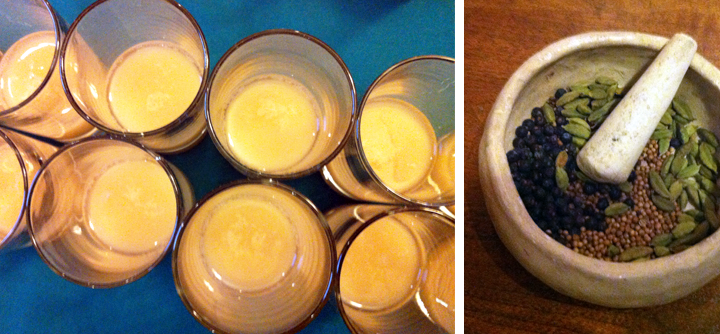
(Photography by Terren Wein)
Not just from a lecture, but a tasting.
The esteemed scholars at the Oriental Institute—who have their priorities in order, as far as I’m concerned—have been working on Sumerian beer for half a century.
In 1964, Miguel Civil, a Sumerologist at the OI, published the first definitive translation of “A Hymn to Ninkasi.” Ninkasi, whose name literally means “lady who fills the mouth,” was the goddess of brewing.
Earlier translations of the hymn, relying on imperfect knowledge of Sumerian, had produced much different results, Civil observed: “A line that now even a first-year Sumerian student will translate ‘you are the one who spreads the roasted malt on a large mat’ was translated ‘thou real producer of the lightning, exalted functionary, mighty one!’”
The hymn describes the brewing process, in oblique, literary, grateful terms. For example:
Ninkasi, you are the one who soaks the malt in a jar,
The waves rise, the waves fall.
You are the one who spreads the cooked mash on
large reed mats,
Coolness overcomes…
You are the one who holds with both hands
the great sweetwort,
Brewing [it] with honey [and] wine…
The fermenting vat, which makes a pleasant sound,
You place appropriately on [top of]
a large collector vat…
While I circle around the abundance of beer,
While I feel wonderful, I feel wonderful,
Drinking beer, in a blissful mood,
Drinking liquor, feeling exhilarated,
With joy in the heart [and] a happy liver—
While my heart full of joy,
[And] [my] happy liver I cover with a
garment fit for a queen!…
The instructions for making beer, murky as they were, now existed in English. But another 25 years passed before anyone attempted to decipher the secret code.
[[{"type":"media","view_mode":"media_original","fid":"1313","attributes":{"alt":"","class":"media-image","height":"619","typeof":"foaf:Image","width":"460"}}]]
(Photography by Terren Wein)
In 1989 the Anchor Brewing Company of San Francisco, working with Civil and a bioanthropologist at the University of Pennsylvania, first tried to brew and bottle a Sumerian-style beer. Its creators pronounced it “drinkable.”
Another 20 years passed before a second attempt was made. This time, Pat Conway, AM’78, of Great Lakes Brewing in Cleveland, was determined not only to use the hymn as a recipe, but to brew the beer in clay vessels like those used 4,000 years ago.
With the help of graduate student Tate Paulette, AM’04, and other OI experts, Great Lakes created three Sumerian beers: Enkibru, a “baseline” beer, as Conway described it; the same beer with date syrup added at the end “to kick off the sweetness”; and Gilgamash, the same beer brewed on 21st-century equipment. The beers are named after Enkidu and Gilgamesh, the main characters in the Epic of Gilgamesh, Paulette explained to me later.
Last month, at a sold-out OI event called “A Hymn to Ninkasi,” I got to try them.
But first we all had to sit through an hour-long lecture by the Sumerologists at the OI and the brewers at Great Lakes. I’d be lying if I didn’t admit I was a bit squirmy by the end.
[[{"type":"media","view_mode":"media_original","fid":"1314","attributes":{"alt":"","class":"media-image","height":"510","typeof":"foaf:Image","width":"460"}}]]
(Photography by Terren Wein)
Nonetheless, here are five things I learned.
1. “Beer production predates the first cities, perhaps by thousands of years,” Sumerologist Chris Woods explained. “Beer production may even be as old as agriculture itself.” Beer in Mesopotamia was consumed by both men and women and all social classes.
2. There are “thousands upon thousands” of references to beer in the clay tablets of Mesopotamia, and yet not a single recipe, Woods continued. “The Hymn to Ninkasi” is the closest thing that has been discovered as of yet.
3. People drank beer out of a communal jar using long reed straws. The beer was probably still actively fermenting, “so you’d have a layer of husks and other stuff on top,” said Paulette. “The straws get down through that top layer, acting as a filter.” Beer drunk through a straw would also get into your system more quickly, he pointed out.
4. The two main ingredients of Sumerian beer were malted barley (barley that has been allowed to germinate) and bappir, usually translated as “beer bread.” But there are two big questions about bappir, Paulette said: “What was it, and how does it fit into the process?”
The OI-Great Lakes group decided to test the possibility that bappir introduced the yeast for fermentation; but if that were the case, the bread couldn’t be baked, or the yeast would die. So they worked with an artisanal baker in Cleveland who baked the bappir at an extremely low temperature—around 100 degrees, about how hot it gets in Iraq in the summer—for up to a week. “It was almost like drying out bread, rather than baking it,” said Paulette.
5. Sumerian beer is not my thing. Enkibru was cloudy and lemony; I heard other, more open-minded tasters describe it as “refreshing” and “kind of like shandy.” Enkibru with date syrup looked and tasted like dish soap; I didn’t hear any nice comments about this one. Gilgamash, brewed on modern equipment, was clear and light, a bit like the wheat beers that I’m partial to. I drank a pint of it and enjoyed it at the time, but woke up the next morning with a college-style hangover. My liver was not filled with joy.
